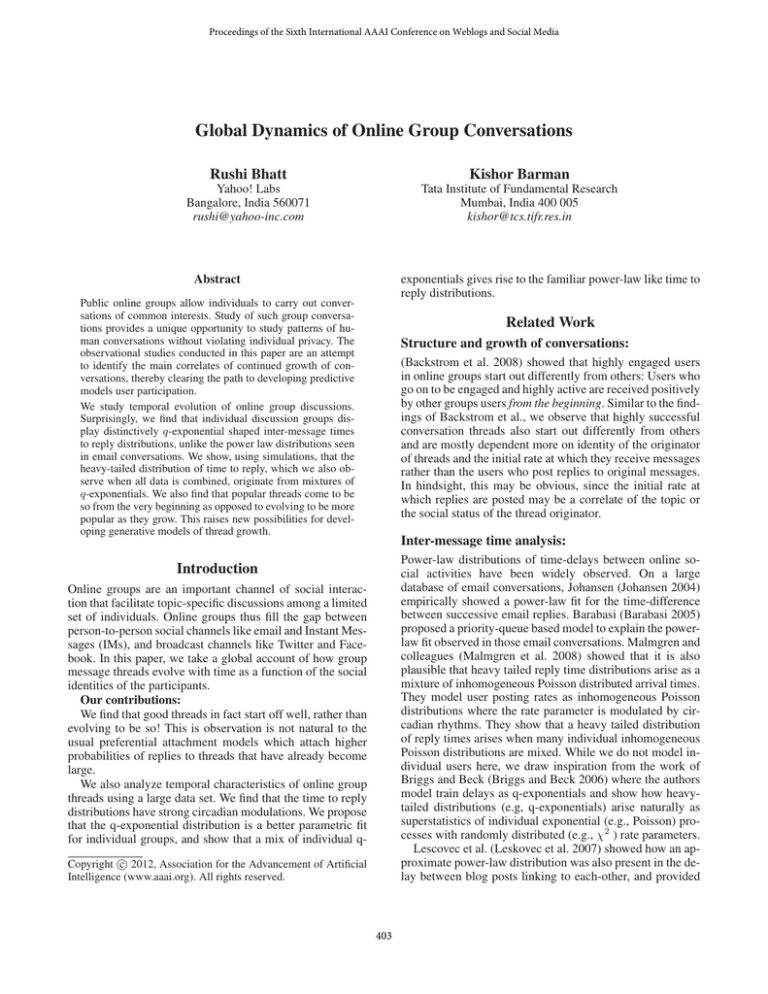
Proceedings of the Sixth International AAAI Conference on Weblogs and Social Media
Global Dynamics of Online Group Conversations
Rushi Bhatt
Kishor Barman
Yahoo! Labs
Bangalore, India 560071
rushi@yahoo-inc.com
Tata Institute of Fundamental Research
Mumbai, India 400 005
kishor@tcs.tifr.res.in
exponentials gives rise to the familiar power-law like time to
reply distributions.
Abstract
Public online groups allow individuals to carry out conversations of common interests. Study of such group conversations provides a unique opportunity to study patterns of human conversations without violating individual privacy. The
observational studies conducted in this paper are an attempt
to identify the main correlates of continued growth of conversations, thereby clearing the path to developing predictive
models user participation.
We study temporal evolution of online group discussions.
Surprisingly, we find that individual discussion groups display distinctively q-exponential shaped inter-message times
to reply distributions, unlike the power law distributions seen
in email conversations. We show, using simulations, that the
heavy-tailed distribution of time to reply, which we also observe when all data is combined, originate from mixtures of
q-exponentials. We also find that popular threads come to be
so from the very beginning as opposed to evolving to be more
popular as they grow. This raises new possibilities for developing generative models of thread growth.
Related Work
Structure and growth of conversations:
(Backstrom et al. 2008) showed that highly engaged users
in online groups start out differently from others: Users who
go on to be engaged and highly active are received positively
by other groups users from the beginning. Similar to the findings of Backstrom et al., we observe that highly successful
conversation threads also start out differently from others
and are mostly dependent more on identity of the originator
of threads and the initial rate at which they receive messages
rather than the users who post replies to original messages.
In hindsight, this may be obvious, since the initial rate at
which replies are posted may be a correlate of the topic or
the social status of the thread originator.
Inter-message time analysis:
Power-law distributions of time-delays between online social activities have been widely observed. On a large
database of email conversations, Johansen (Johansen 2004)
empirically showed a power-law fit for the time-difference
between successive email replies. Barabasi (Barabasi 2005)
proposed a priority-queue based model to explain the powerlaw fit observed in those email conversations. Malmgren and
colleagues (Malmgren et al. 2008) showed that it is also
plausible that heavy tailed reply time distributions arise as a
mixture of inhomogeneous Poisson distributed arrival times.
They model user posting rates as inhomogeneous Poisson
distributions where the rate parameter is modulated by circadian rhythms. They show that a heavy tailed distribution
of reply times arises when many individual inhomogeneous
Poisson distributions are mixed. While we do not model individual users here, we draw inspiration from the work of
Briggs and Beck (Briggs and Beck 2006) where the authors
model train delays as q-exponentials and show how heavytailed distributions (e.g, q-exponentials) arise naturally as
superstatistics of individual exponential (e.g., Poisson) processes with randomly distributed (e.g., χ2 ) rate parameters.
Lescovec et al. (Leskovec et al. 2007) showed how an approximate power-law distribution was also present in the delay between blog posts linking to each-other, and provided
Introduction
Online groups are an important channel of social interaction that facilitate topic-specific discussions among a limited
set of individuals. Online groups thus fill the gap between
person-to-person social channels like email and Instant Messages (IMs), and broadcast channels like Twitter and Facebook. In this paper, we take a global account of how group
message threads evolve with time as a function of the social
identities of the participants.
Our contributions:
We find that good threads in fact start off well, rather than
evolving to be so! This is observation is not natural to the
usual preferential attachment models which attach higher
probabilities of replies to threads that have already become
large.
We also analyze temporal characteristics of online group
threads using a large data set. We find that the time to reply
distributions have strong circadian modulations. We propose
that the q-exponential distribution is a better parametric fit
for individual groups, and show that a mix of individual qc 2012, Association for the Advancement of Artificial
Copyright Intelligence (www.aaai.org). All rights reserved.
403
a generative law that gave rise to the observed power law
distributions.
1e−06
Density
2e+03
1e+04
5e+04
2e+05
1e−08
1e−10
Density of reply times
q−exponential fit
5e−10
We use one of the world’s largest collections of online discussion boards. From this Groups data we chose only the
public groups that were moderated and active at the time
of data collection. Of these, we retained groups with at
least 10 total messages and at least 10 unique subscribers.
Roughly 10,000 groups with about 14 million total messages
remained after filtering. The data was collected in January
2010 and contained all messages in the selected groups up
to that time, spanning nearly 10 years.
While individual users may receive updates through different channels (email, consolidated digests, direct website
visits) we do not discriminate between these in our analysis.
5e−08
Density
Data description
5e−09
Preliminaries
1e+06
Density of reply times
q−exponential fit
2e+03
Inter−reply time (Seconds)
5e+04
2e+05
1e+06
(b) Group 2
q 1.75 kappa 22909
Density
1e−08
1e−10
Temporal dynamics of message posting
2e+03
1e+04
5e+04
2e+05
1e+06
Inter−reply time (Seconds)
(c) Group 3
Density of reply times
q−exponential fit
1e−10
Density of reply times
q−exponential fit
1e−08
1e−06
1e−06
q 1.83 kappa 43998.9
Density
1e+04
Inter−reply time (Seconds)
(a) Group 1
In this section, we will present an overview of some temporal characteristics of time to reply differences that seem
unique to discussion groups.
2e+03
1e+04
5e+04
2e+05
1e+06
Inter−reply time (Seconds)
(d) Group 4
Figure 2: Density of the time to reply distributions of the
individual groups, and their Maximum Likelihood fit to qexponentials.
Ove all
Largest Group
Next 5 top Groups
1e−07
modulations in time to reply distributions. In the overall time
to reply distribution across all groups we observe distinct
knee points at two hours and one day (See Figure 1). Keeping the distribution between two hours and one day as a reference, we see that there is lower mass in the distribution at
less than two hours and more than one day compared to what
a power law would predict. We observe more prominent circadian modulation than in some email data sets (Malmgren
et al. 2008) and see traces of a weekly modulation as well,
similar to blog link creation time course (Leskovec et al.
2007).
Visually, the time to reply distributions for individual
groups seem to be q-exponentials. A random variable X
is q-exponentially distributed with shape and scale parameters q and κ, respectively, if its upper cumulative (or
complementary) distribution function is P r[X ≥ x] =
1
1−q
1 − (1−q)x
(Picoli, Mendes, and Malacarne 2003).
κ
The q-exponential distribution has been used in the literature
for modeling social network growth (White et al. 2006).
In Figure 2 we show reply time distributions for some of
the largest groups and their corresponding q-exponential fits
obtained by a Maximum Likelihood estimate (Shalizi 2007).
1e−09
1e−08
Dens ty
1e−06
1e−05
q 1.87 kappa 37166.4
5e−07
q 0.67 kappa 1130669.8
2e+03
5e+03
1e+04
2e+04
5e+04
1e+05
2e+05
5e+05
1e+06
Inter reply time (Seconds)
Figure 1: Time delay between successive messages is distinctly non-power law. We also see a strong circadian rhythm
and “knee points” at two hours, and one day, followed by
successive daily peaks (dashed vertical lines at 2 hrs, 1 day,
1 week)
q-exponentials describe time to reply distributions
The familiar power law distribution of the size of threads
exists, with probability of observing a thread of size k following distribution p(k) ∝ k −α for some α. On the other
hand, the distribution of times to reply r(v, u) for individual groups, and to an extent over the whole data, follows a
distinctively non-power law distribution. For example, Figure 1 shows the top 6 individual groups show lighter tailed
distributions (gray lines) than what a power law distribution
would predict. However, time to reply distribution accumulated over all the groups may still be closer to a power law
(dark line in Figure 1). We also observe strong circadian
Mixture of q-exponentials result in power law From the
above observations, we postulate that for individual groups,
time to reply are q-exponential distributed. We also postulate
that when a right mix of q-exponentials is accumulated over
all individual groups, it is possible to generate an overall dis-
404
Density
1e−05
1e−03
1e−07
5e+03
2e+04
1e+05
5e+05
Generated reply times
2e+06
(a) Group 1
(b) Group 2
(c) Over all groups
(d) Mean first reply time vs.
Degree
Density
1e−14
0
2
4
6
q−values
8
10
1e−22
0.0
Density
0.2
0.4
1e−06
Figure 3: Power law distribution of simulated time to reply
aggregated over all the groups (1000 groups), when the time
to reply for each groups is generated using q-exponentials.
2e+05
(a) q-values
1e+06 5e+06
kappa−values
5e+07
Figure 5: (a,b,c) Thread size vs mean first reply time for two
largest groups and over all the groups. The X axis represents
thread size, and the Y axis represents mean first reply times.
(b) Messages that receive many replies also get a quicker
first reply. The red curves indicate LOWESS smoothening.
(b) κ-values
Figure 4: Distribution of the parameters of q-exponential fit
across groups.
tribution close to a power-law. For example, Figure 3 shows
a resulting distribution when we mix 1000 independent qexponential distributions. For our simulations, we first estimated individual group-level q-exponential parameters. We
then sampled 1000 points from these parameter distributions
and sampled equal number of samples from the distributions governed by these parameters. When samples across
all groups are merged, these individual q-exponential distributions give rise to a power law like distribution (see Figure 3).
Figure 4 shows the distributions of shape parameter q
(Figure 4(a)) and the scale parameter κ (Figure 4(b)) estimated by Maximum Likelihood estimates for each of the
1000 groups.
time to first reply to a root message vs. thread size. Generally, first replies to the root message arrive much quicker
for threads that grow to receive many replies. This is true
within a group (not shown here due to space constraints),
as well as aggregated over all the groups (Figure 5(c)). Kumar et al. (Kumar, Mahdian, and McGlohon 2010) also observed that the exponent of degree distribution power law decreases with depth in threads, i.e., thread trees tend to have
fewer answers at higher depths. This suggests that popular
threads usually are popular from the start, and begin receiving quicker replies right from the time the root message is
posted. In other words, the root message content or the identity of its author determine, to a large extent, the eventual
success of a thread.
Temporal Structure of Threads
We now turn to understanding the characteristics of individual threads. We would like to find out what may be the
drivers of user participation, and whether there are any social attributes of ongoing threads that attract increased and
quicker participation.
First reply time predicts degree We would also expect
that if a message receives a quick first reply, then probably it is interesting enough to receive many more subsequent
replies. Indeed this is true. Figure 5(d) shows how messages
with higher degree also generally have quicker first reply
times.
Popular threads generate high interest from start A
popular thread could be popular from the start, or it could
start slow and gain popularity at a later stage. We want to
understand which of these possibilities prevail. To that end
we look at how time to first reply to the root message relates to the eventual thread size. Figure 5 shows the average
Mean reply time over the whole thread has no systematic relation to thread size We saw how time to first reply
to the root message correlates well with the eventual thread
size. The average delay over all replies to a message, on the
other hand, paints a completely different picture. For many
groups, we in fact see an increase in the mean reply time
405
References
Backstrom, L.; Kumar, R.; Marlow, C.; Novak, J.; and
Tomkins, A. 2008. Preferential behavior in online groups. In
Proceedings of the international conference on Web search
and web data mining, WSDM ’08, 117–128. New York, NY,
USA: ACM.
Barabasi, A.-L. 2005. The origin of bursts and heavy tails
in human dynamics. NATURE 435:207.
Briggs, K., and Beck, C. 2006. Modelling train delays with
q-exponential functions. arXiv.
Johansen, A. 2004. Probing human response times. Physica
A: Statistical Mechanics and its Applications 338(1-2):286
– 291. Proceedings of the conference A Nonlinear World:
the Real World, 2nd International Conference on Frontier
Science.
Kumar, R.; Mahdian, M.; and McGlohon, M. 2010. Dynamics of conversations. In Proceedings of the 16th ACM
SIGKDD international conference on Knowledge discovery
and data mining, KDD ’10, 553–562. New York, NY, USA:
ACM.
Leskovec, J.; McGlohon, M.; Faloutsos, C.; Glance, N. S.;
and Hurst, M. 2007. Patterns of cascading behavior in large
blog graphs. In SDM. SIAM.
Malmgren, R. D.; Stouffer, D. B.; Motter, A. E.; and Amaral, L. A. N. 2008. A Poissonian explanation for heavy
tails in e-mail communication. Proc. Natl. Acad. Sci. U.S.A.
105:18153–18158.
Picoli, S.; Mendes, R. S.; and Malacarne, L. C. 2003. qexponential, weibull, and q-weibull distributions: an empirical analysis. Physica A: Statistical Mechanics and its Applications 324(3-4):678 – 688.
Shalizi, C. R. 2007. Maximum Likelihood Estimation for qExponential (Tsallis) Distributions. arXiv math/0701854v2.
White, D. R.; Kejžar, N. c. v.; Tsallis, C.; Farmer, D.; and
White, S. 2006. Generative model for feedback networks.
Phys. Rev. E 73(1):016119.
Figure 6: Across groups, baseline reply-receive times of
parent-node authors are better correlates of time-to-reply
with thread size (not shown here due to space constraints).
We also see that for some groups, the mean reply time
oscillates unpredictably as the thread size grows. We looked
at a large number of threads but found no systematic pattern
in thread size vs. mean times to reply.
Parent author is more predictive of time to reply
For each group G as we compute two correlation coefficients. First, we correlate the time to reply with
the baseline posting rates of authors of replies, called
the author baseline. Specifically, for each message pair
(parent(v), v) posted in group G we compute Pearson’s correlation coefficient Ra (G) between quantities
r(parent(v), v) and author baseline(author(v)). Second, we correlate the time to reply with the average rate at
which a given user’s posts receive replies, called the parent baseline. In other words, we compute Pearson’s correlation coefficient Rp (G) between r(parent(v), v) and
parent baseline(parent author(v)). As seen in Figure 6,
the parent baseline correlates better with time-to-replies in
a thread than the author baseline
Discussion and Conclusions
The evolution of conversations when limited amount of information is visible to users is not yet completely characterized. Most of the generative models in the literature explicitly use the current degree (the number of friends a user
has, total replies so far) for creating new edges. It is unknown whether users in fact take this information explicitly
into consideration, or always have access to this information
while creating links. Preferential attachment models are thus
at best a proxy when current degree is not available to users
during link creation. These aspects of evolutions of conversations remain to be investigated. In this paper, we showed
how the initial few posts in a thread matter in the ultimate
size of threads, and how there are non-trivial temporal aspects of thread evolution that are not captured by popular
models.
406



